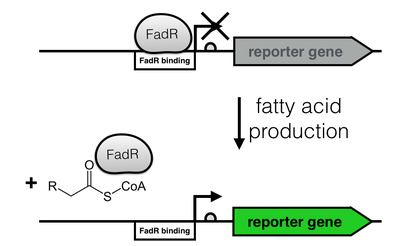Part:BBa_K2924015
Promoter aldA from the Escherichia coli genome
The promoter aldA was published as an oleic acid (C18:1) sensitive promoter enabling for the measurement of free fatty acids present in microorganisms.
Usage and Biology
In Escherichia coli the growth on fatty acids requires many different proteins which are repressed by the transcriptional factor FadR.1 The long chain acyl-CoA ester is an effector on the transcriptional factor FadR for the regulation of fatty acid metabolism.2
After adding oleic acid (C18:1) many proteins showed an altered expression level and new proteins like AldA were synthesised. The promoter for aldA was also used for the production of green fluorescent protein (GFP).1 PaldA was isolated from the Escherichia coli wild type genome.
Sequence and Features
- 10COMPATIBLE WITH RFC[10]
- 12COMPATIBLE WITH RFC[12]
- 21COMPATIBLE WITH RFC[21]
- 23COMPATIBLE WITH RFC[23]
- 25COMPATIBLE WITH RFC[25]
- 1000COMPATIBLE WITH RFC[1000]
Characterization
The sensitivity of the promoter to fatty acids was tested with the reporter gene eYFP (BBa_E0030) in the composite part BBa_K2924017. Different long-chain fatty acids, like palmitic acid, stearic acid and oleic acid were used for the characterization. Also different concentrations from 0.01 mM to 1 mM were used of the fatty acid palmitic acid and stearic acid. For the fatty acid oleic acid, the concentrations from 0.5 mM to 10 mM were used.

The measurement showed that the PaldA promoter produced a high amount of eYFP when oleic acid (C18:1) was added to the culture. In addition, PaldA can also detect stearic acid (C18:0) the saturated form of oleic acid, as well as palmitic acid(C16:0), although with a weaker absolute fluorescence value than oleic acid (C18:1).
References
1: Mee-Jung Han, Jeong Wook Lee, Sang Yup Lee, and Jong Shin Yoo. “Proteome-Level Responses of Escherichia coli to Long-Chain Fatty Acids and Use of Fatty Acid Inducible Promoter in Protein Production” Hindawi Publishing Corporation Journal of Biomedicine and Biotechnology Volume 2008, Article ID 735101,12 pages
2: D. P. Clark and J. E. Cronan Jr., “Two-carbon compounds and fatty acids as carbon sources,” in Escherichia coli and Salmonella: Cellular and Molecular Biology, F. C. Neidhardt, R.Curtiss III, J. L. Ingraham, et al., Eds., pp. 343–357, ASM Press,Washington, DC, USA, 1996
| None |

